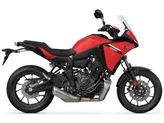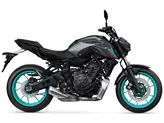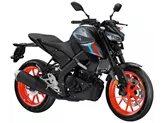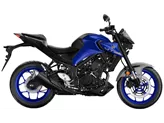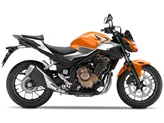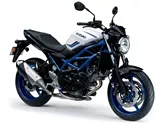Yamaha MT-07 2014 vs. Suzuki SV 650 2016

Yamaha MT-07 2014

Suzuki SV 650 2016
Vue d’ensemble - Yamaha MT-07 2014 vs Suzuki SV 650 2016
The Yamaha MT-07 2014 and the Suzuki SV 650 2016 are both naked bikes with similar engine types, cooling systems, and cylinder configurations. However, there are several key differences between the two models.
In terms of engine power, the Yamaha MT-07 2014 has a slightly lower output of 75 HP compared to the Suzuki SV 650 2016's 76 HP. However, the Yamaha MT-07 2014 has a higher torque of 68 Nm compared to the Suzuki SV 650 2016's 64 Nm. This means that the Yamaha MT-07 2014 may have slightly better acceleration and pulling power.
Both bikes have telescopic fork front suspensions and steel frames, which provide stability and control. The Yamaha MT-07 2014 has double disk front brakes, while the Suzuki SV 650 2016 also has double disk front brakes. This ensures powerful and reliable braking performance for both models.
In terms of tire dimensions, the Yamaha MT-07 2014 has a wider rear tire width of 180 mm compared to the Suzuki SV 650 2016's 160 mm. This may provide slightly better traction and stability for the Yamaha MT-07 2014.

Yamaha MT-07 2014
The wheelbase of the Yamaha MT-07 2014 is shorter at 1400 mm compared to the Suzuki SV 650 2016's 1445 mm. This may result in slightly more agile and maneuverable handling for the Yamaha MT-07 2014.
The seat height of the Yamaha MT-07 2014 is slightly higher at 805 mm compared to the Suzuki SV 650 2016's 785 mm. This may be more comfortable for taller riders on the Yamaha MT-07 2014.
In terms of weight, the Yamaha MT-07 2014 is lighter with a kerb weight of 182 kg compared to the Suzuki SV 650 2016's 197 kg. This may contribute to the Yamaha MT-07 2014's light and nimble handling.

Suzuki SV 650 2016
Both models have similar fuel tank capacities, with the Yamaha MT-07 2014 having a slightly larger capacity of 14 l compared to the Suzuki SV 650 2016's 13.8 l. This may result in slightly longer riding range for the Yamaha MT-07 2014.
In terms of strengths, the Yamaha MT-07 2014 is praised for its extremely agile engine, very light handling, low weight, aggressively angular appearance, powerful brakes, comfortable seating position, throaty sound, and extensive and easy-to-read display. On the other hand, the Suzuki SV 650 2016 is praised for its agile and powerful engine, typical V2 sound, pleasant and low seating position, easy handling, comfortable chassis, and brakes with good control.
However, the Yamaha MT-07 2014 does have some weaknesses, including a slightly soft suspension, footrests that drag quickly, partly cheap plastic parts, and a boring telescopic fork. The Suzuki SV 650 2016's only weakness mentioned is a poorly readable digital tachometer.
In conclusion, the Yamaha MT-07 2014 and the Suzuki SV 650 2016 are both solid naked bike options with their own strengths and weaknesses. The Yamaha MT-07 2014 may offer slightly better acceleration and handling, while the Suzuki SV 650 2016 may provide a more comfortable seating position and better control. Ultimately, the choice between the two models will depend on the rider's preferences and priorities.
Caractéristiques techniques Yamaha MT-07 2014 par rapport à Suzuki SV 650 2016
Avantages et inconvénients en comparaison
Avantages et inconvénients en comparaison
Yamaha MT-07 2014

La MT-07 est une incroyable machine de plaisir qui se laisse conduire de manière extrêmement sportive. Le moteur est de loin le plus agile de sa catégorie, et même au-delà.
Suzuki SV 650 2016

La nouvelle SV650 s'inscrit dans la lignée du minimalisme visuel des deux premières générations de SV650, tout en se basant techniquement sur son prédécesseur direct, la SFV650 Gladius - deux excellents coups qui font de la très moderne SV650 un classique. Le design s'inscrit parfaitement dans l'époque des nombreuses transformations rétro, mais à l'intérieur sommeillent aussi des gadgets modernes qui facilitent l'apprentissage, surtout pour les débutants. Le moteur, quant à lui, peut également convaincre les pilotes confirmés, le vrombissement typique du V2 est magnifique. En ce qui concerne le châssis et les freins, il ne faut pas s'attendre à une sportivité extrême, mais le prix de près de 6400 euros (en Allemagne) est une annonce qui fera sans doute avaler la poussière à la concurrence.
Comparaison des prix Prix moyen du marché Yamaha MT-07 vs Suzuki SV 650
There are a few key differences between a Yamaha MT-07 2014 and a Suzuki SV 650 2016. In terms of price, the actual average price of a Yamaha MT-07 2014 is about 3% higher. A Yamaha MT-07 2014 experiences a loss of 160 USD in one year and 220 USD in two years of ownership. This is offset by a loss of 140 USD and 140 USD for a Suzuki SV 650 2016. Compared to Suzuki SV 650 2016 there are more Yamaha MT-07 2014 bikes available on the 1000PS.de Marketplace, specifically 17 compared to 11. It takes less time to sell a Yamaha MT-07 with 37 days compared to 80 days for a Suzuki SV 650. Since model year 2013 1000PS.de editors have written 69 reviews for the Yamaha MT-07 and 25 reviews for the Suzuki SV 650 since model year 2005. The first review for the Yamaha MT-07 was published on 11/4/2013 and now has more than 12,600 views. This compares to more than 14,200 views for the first review on Suzuki SV 650 published on 9/26/2008.


